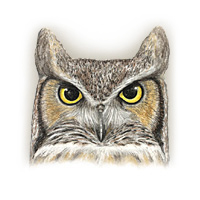 |
Great Horned Owl
Bubo virginianus |
|
STANFORD LOCATIONS: Several pairs are resident on campus. Nests in tall trees (such as eucalyptus), often in old Red-tailed and Red-shouldered hawk nests. A pair usually nests in the arboretum. |
 |
Location |
Type |
Mating System |
Parental Care |
2ndary Diet |
Strategy |
|
|
NEST |
|
I: 26-35 DAYS SEMIALTRICIAL 2 |
|
|
|
(15 feet - 70 feet) CLIFF |
|
(1-6+) MONOG? |
MF |
SM VERTS INSECTS |
| BREEDING: | Conif or decid forest and woodland, swamp, orchard, park, riparian forest, semidesert. 1 brood. |
| DISPLAYS: | Male performs noisy aerial courtship display; ritually feeds female. Pair bill, bob, call, and click. |
| NEST: | In abandoned tree nest of raptor, corvid, occ squirrel; also tree cavity, cave, crevice, stump, and on ground in log, among rocks; of sticks, moss, hair, shredded bark, rootlets, etc., lined slightly with feathers and down. Perennial. |
| EGGS: | Dull white. 2.2" (55 mm). |
| DIET: | Esp rabbits and rodents, pheasants, quail, passerines, occ fish, amphibians, reptiles, scorpions. Mainly nocturnal, but also hunts crepuscularly. Ejects pellets. |
| CONSERVATION: | Winter resident. Occ uses nest box. |
| NOTES: | Incubating bird often snow-covered in n; early eggs may freeze. Population density in n tracks snowshoe hare density; disperse when hare numbers crash. Young hatch asynchronously; rapidly develop ability to regulate body temperature, fly at 63-70 days, fed for several months. Adults perform distraction display. Daytime roost in dense conif near trunk. Most do not breed before second year. Arctic populations eat more birds. Cache prey; defrost frozen cache by "incubating" it ("prey thawing"). |
| ESSAYS: | Irruptions; Pellets; How Owls Hunt in the Dark; Mobbing; Brood Reduction; Breeding Season. |
| REFERENCES: | Adamcik and Keith, 1978; Marti, 1974; Turner and McClanahan, 1981. |
| Help | Abbreviations | Species-Alphabetical | Species-Taxonomic | Essays-Alphabetical | |
| Except for Stanford Locations, the material in this species treatment is taken, with permission, from The Birder's Handbook (Paul Ehrlich, David Dobkin, & Darryl Wheye, Simon & Schuster, NY. 1988). | |||||